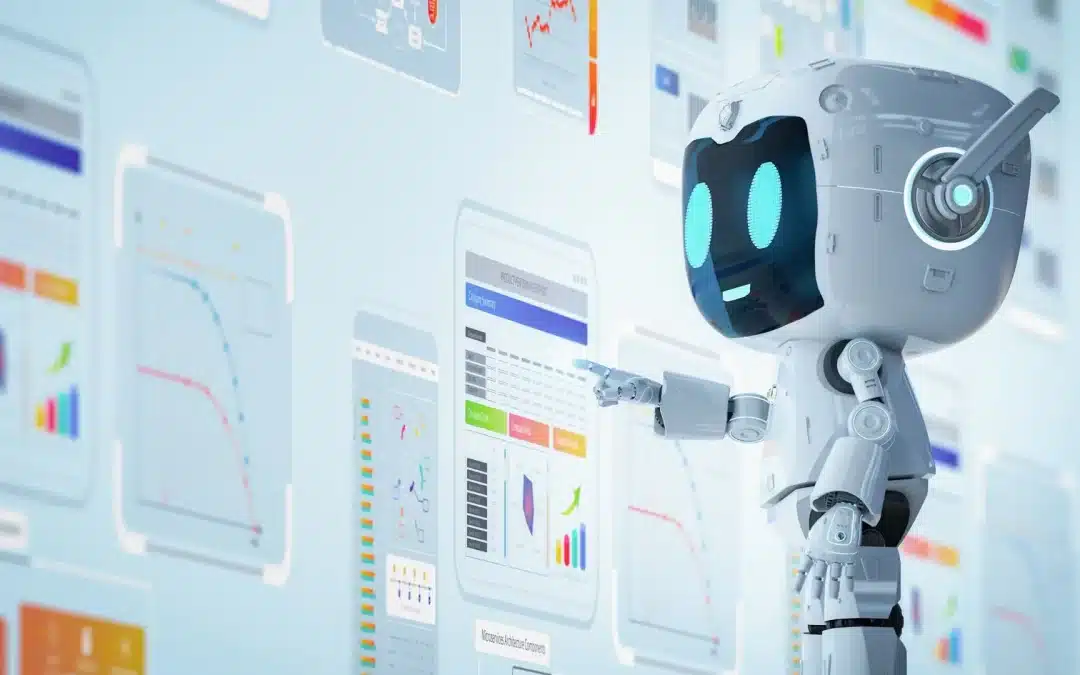In artificial intelligence applied to business, Database Chatbots represent one of the most promising evolutions to simplify access to business information. But what are they exactly? How do they work? And above all, what benefits can they bring to a company? In this article we explain everything you need to know.
What are Database Chatbots
Database Chatbots are virtual assistants designed to interact with structured or unstructured databases using natural language. Unlike traditional chatbots that answer pre-set questions, Database Chatbots use advanced Natural Language Processing (NLP) and query generation technologies to interpret user questions and return relevant answers by drawing directly from one or more data sources.
In practice, they allow anyone – even without technical skills – to “talk” to a database as if they were talking to an expert colleague.
How do they work
- Understanding the request: the chatbot analyzes the user’s intent
- Query Translation: Database chatbots convert the request into a query (e.g. SQL, Elasticsearch, API call)
- Data retrieval: they run the query against the database or a document system
- Natural Response: they return results in a conversational and understandable form.
Types: SQL Chatbots vs Excel Chatbots
SQL Chatbots
These chatbots are connected to relational databases (e.g. PostgreSQL, MySQL, SQL Server) and generate SQL queries from natural language questions. They are useful for analysts, managers and business teams who want to consult data without having to write code.
Example: “What are the five best-selling products in the first quarter?”
The chatbot recognizes the intent, generates a SQL query with time filtering, sorting, and limiting results, and then returns a clear output.
Excel Chatbots
Many companies still use Excel spreadsheets as informal archives. Excel Chatbots read these files (typically converted into dataframes or loaded into a backend like Google Sheets) and allow natural language queries.
Please note: these chatbots do not execute SQL queries on Excel, but operate through semantic engines and content indexing techniques.
What are the advantages for companies?

Introducing a Database Chatbot in your company can revolutionize data access and improve operational efficiency. Here are the main benefits:
- Immediate access to information: no more complex searches or requests to IT departments to obtain data.
- Reduced response times: instant answers even to complex questions.
- Staff empowerment: all employees, regardless of their role, can query systems and databases.
- Better customer service: chatbots can respond in real time to customer requests based on always up-to-date information.
- Faster and more informed decisions: having access to the right data at the right time improves the quality of decisions.
Database Chatbots and Business Intelligence
The integration between chatbots and Business Intelligence systems creates a powerful synergy: chatbots become not only reactive, but also proactive and analytical tools. This combination allows companies to offer smarter conversational experiences, obtain useful insights in real time and improve performance on various fronts – from customer support to marketing, to operational management.
For example, in customer service, chatbots can analyze open tickets in real time to identify recurring patterns and suggest corrective actions. In marketing, they can propose personalized offers based on the analysis of the user’s purchasing behavior. In the retail sector, they can generate automatic reports on sales trends starting from requests from store managers. And in the HR sector, they can support managers in analyzing internal sentiment by collecting qualitative data from employees and transforming them into strategic indicators.
Security and architecture
Database Chatbots do not directly access corporate databases
A good Database Chatbot solution never directly accesses the corporate database. This approach is essential to ensure data security, scalability and governance. In practice, the chatbot sends requests in natural language to an intermediate system (typically an API or a controlled query engine) that interprets the question, generates the query and returns only the necessary results. Access to the data therefore occurs in “read-only” mode and always through controlled channels, avoiding any direct or privileged connection to the core systems. In this way, the infrastructure remains protected from potential risks related to attacks, configuration errors or unauthorized access, while maintaining the flexibility needed to respond in real time to users’ information needs.
Database Chatbots Use Cases

Internal Support
Database Chatbots are also a valuable resource for internal support to business functions, automating access to operational information and reducing dependence on administrative or IT teams. In HR, for example, an employee can ask the chatbot:
“How many vacation days do I have left?”
“When will the next paycheck be credited?”
“Where can I find the remote work policy?”
The chatbot, connected to internal portals, HR management and company documentation, returns immediate and personalized answers, reducing email requests and improving internal satisfaction.
In the Finance department, Database Chatbots can provide access to updated financial reports, allow comparison between KPIs on a time basis or by company area, and answer questions such as:
“What was the budget spent on marketing in the first quarter?”
“Show me the comparison between expected and actual costs for the current month.”
“What is the trend of cash flow in the last six months?”
Thanks to natural language consultation and integration with company systems, Database Chatbots simplify the lives of collaborators and managers, improving operational efficiency and the quality of decisions, even in complex or distributed contexts.
Customer support
In customer service, Database Chatbots offer a powerful tool to improve the quality of customer service and drastically reduce response times. Connected to knowledge base databases, order history, CRM and management systems, these chatbots are able to provide timely, up-to-date and personalized answers on a wide range of topics, without the need for human intervention.
Customers can ask, for example:
“What is the status of my shipment?”
“How can I request an invoice for my order?”
“Is product X available in stock?”
“What are the return conditions for the item I purchased?”
The chatbot processes the request in natural language, queries company databases and returns answers in real time, even during hours not covered by traditional customer care. This means improving the customer experience, reducing the number of open tickets and lightening the load on the support team, which can then focus on more complex cases.
Furthermore, thanks to the ability to learn from feedback and integration with analytics tools, Database Chatbots help monitor recurring themes, identify systemic problems and suggest continuous improvements to customer service.
e-commerce Database Chatbots
In the e-commerce sector, Database Chatbots can make the difference between a smooth and a frustrating purchasing experience. Connected to the product management system, CRM and order database, the chatbot can answer questions in real time about availability, prices, delivery times, return policies and order status.
It can also assist customer service, drastically reducing open tickets and managing peaks in requests during promotional events or high seasonal periods (such as Black Friday). Furthermore, it can be used by the marketing team to analyze purchasing behaviors and identify the most requested products based on period, geographic area or category.
Manufacturing & supply chain
In the industrial sector, Database Chatbots represent a strategic tool to improve operational efficiency and support real-time decisions. They can be integrated with ERP systems, warehouse databases, MES (Manufacturing Execution System) platforms and logistics management software, allowing operators, production managers or logistics managers to quickly obtain critical information.
For example, you can ask the chatbot:
“What is the current stock level of product X?”
“How many orders are waiting to be shipped?”
“Which machines have recorded anomalies in the last week?”
Database Chatbots reduce the need to manually access multiple systems and help minimize human errors, prevent production bottlenecks, and optimize the supply chain. Additionally, they provide a competitive advantage in terms of data visibility and speed of response, especially in environments where time and accuracy are critical factors.
Database Chatbots for Finance
In the Finance department, Database Chatbots can greatly simplify access to accounting data, reporting and economic indicators, offering immediate support to controllers, CFOs and analysts. For example, you can ask:
“What is the gross operating margin for the current month?”
“What are the highest variable costs compared to last month?”
“Show me the revenue trend by division over the last three quarters.”
The main advantage is the reduction of analysis times, the standardization of responses and the elimination of errors resulting from manual consultation of data. In addition, these chatbots can help to monitor anomalies in cash flows or costs, supporting financial governance in a more agile and proactive way.
Database Chatbots for IT
In IT, Database Chatbots can become a centralized access point to query system logs, ticketing databases, server performance, or monitoring tools. For example, a technician can ask:
“Which tickets have been open for more than 48 hours?”
“Has there been any server downtime this week?”
“Which users reported access issues today?”
In complex environments, these chatbots help quickly identify critical issues, speed up incident resolution, and reduce the time spent searching for information across multiple systems. They can also be used to guide internal users through common IT procedures, such as password reset or VPN configuration, improving the efficiency of technical support
Chatbot Database vs AI Agents: What are the differences?
Although they may seem similar, Database Chatbots and AI Agents have different roles and capabilities. Database Chatbots are designed to query databases and return timely information, acting as an interface between the user and an information system. Their main purpose is to simplify access to data, translating questions into queries and displaying precise answers.
AI Agents, on the other hand, are autonomous entities capable of reasoning, planning and acting proactively to achieve a goal. In addition to retrieving information, they can orchestrate complex tasks, involve multiple tools and make autonomous decisions (for example, contacting customers, updating records, booking an appointment). In short: Database Chatbots respond, AI Agents act.
Conclusions
Database Chatbots represent a powerful and accessible innovation for any company that wants to optimize the use of data and improve the experience of internal and external users. They offer an intuitive and immediate way to query business systems, reducing the load on the IT department and democratizing access to information. And while AI Agents are preparing to handle increasingly complex tasks, Database Chatbots remain an effective, concrete and easily integrable solution to enhance productivity and accelerate decisions.

